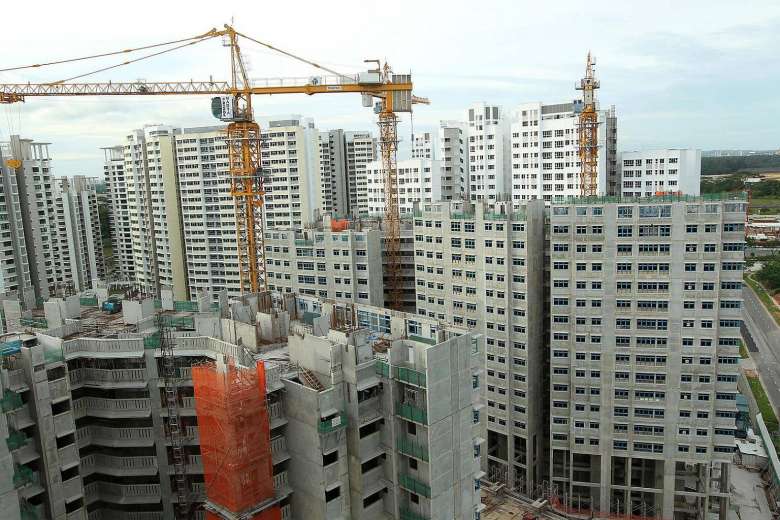Executive condos regain shine in lacklustre market.
As of September this year, Sol Acres at Choa Chu Kang Grove had 733 unsold units. For the first nine months of this year, the number of vacant units (completed but unoccupied) remained above 2,000. PHOTO: SOL ACRES
Total sales in the first 9 months this year have exceeded the number sold last year
SINGAPORE — With bargain hunters on the prowl, executive condominiums (ECs) have become attractive options in a tepid property market, as vacancy rates and the number of unsold units fall in tandem with declining prices.
Property analysts TODAY spoke to noted that the median price of ECs has fallen 6 per cent from S$826 per square foot (psf) in the first three months of last year to S$773 psf in the third quarter of this year.
The fall in prices, along with the raising of the eligibility income ceiling about a year ago, saw sales of ECs climbing to a near four-year high of 1,398 units in the third quarter of this year, based on figures by the Urban Redevelopment Authority (URA). Total sales in the first nine months this year of 3,265 units have exceeded the 2,550 ECs sold in the whole of last year.
“The rise in income ceiling certainly helped to enlarge the pool of buyers. What makes ECs attractive is also that there is still a considerable gap between EC prices and private property prices,” said Mr Eugene Lim, key executive officer of property agency ERA Realty.
URA data showed that the median transacted prices of EC developments Signature at Yishun and The Criterion, both located in Yishun Street 51, were S$759 psf and S$798 psf, respectively in September.
A private residential project in the nearby vicinity of Yishun Close was sold at a median S$1,035 psf in the same month — or 30 per cent to 36 per cent higher than the ECs.
ECs are hybrid public-private homes that cater to the needs of the sandwich class whose household incomes exceed the ceiling for public housing but are unable to afford a private property. They are built and sold by private developers but have eligibility criteria for purchase and sale, such as Housing and Development Board (HDB) flats.
The conditions include gross household income not exceeding S$14,000 a month — up from S$12,000 last year.
EC owners can only sell their units in the open market with some restrictions after fulfilling a five-year minimum occupation period. These restrictions are fully lifted after the 10th year, making ECs no different from private residences.
“Many of the ECs, whether they’re in the north or north-east, are in HDB estates and you get to tap into the infrastructure in these estates, such as MRT stations, shopping complexes, schools and clinics,” said Mr Chris Koh, director of property firm Chris International. “And today, with most EC prices below S$800 psf, you get a reasonably-sized unit with a budget of up to S$1 million and it’s an avenue to owning a private property.”
The better sales performance in recent months has helped developers offload their unsold inventory, with unsold units falling to an 18-month low of 3,625 units by September.
Coincidentally, vacancy rates in the third quarter also fell to the lowest this year at 10.8 per cent, showed URA data.
Despite that, Mr Ku Swee Yong, key executive of International Property Advisor, said there are still indications of an oversupply of ECs.
He noted that for the first nine months of this year, the number of vacant units — those completed and not occupied — consistently stayed above 2,000.
Total vacant units were at 2,901 in the first quarter, 2,943 in the second quarter, and 2,426 in the third quarter, showed URA data.
“There could be investors who bought not because they want to live there,” said Mr Ku. “They could be still staying with their parents or somewhere else, have collected keys to the ECs but (are) not moving in.
“There are many dual-key units in EC developments, so the owner can rent one of the sub-units out, but now that the rental market is not good, many units are left vacant,” said Mr Ku, adding that this means genuine demand has been met and there is an oversupply situation.
Owners cannot rent out their ECs during the minimum occupation period but they can rent out rooms within the units during this period.
Mr Lim said EC prices will continue to be kept in check in the current cautious buying climate and uncertain macroeconomic conditions.
Measures such as the income ceiling and the Mortgage Servicing Ratio, which caps housing loans at 30 per cent of the buyer’s gross monthly income, mean that developers have to price their offerings to cater to buyers from a specific income group.
They also have to manage risks arising from the 15-month stipulated gap between the award of sites, or completion of foundation works, and launch.
“The measures have allowed the market to have a breather and time to soak up the excess supply. Developers are pricing to sell now, so it’s a good time for buyers to shop around,” he said.



